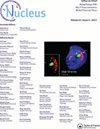In situ nuclear matrix preparation in Drosophila melanogaster embryos/tissues and its use in studying the components of nuclear architecture
IF 4.5
3区 生物学
Q3 CELL BIOLOGY
引用次数: 4
Abstract
ABSTRACT The study of nuclear matrix (NuMat) over the last 40 years has been limited to either isolated nuclei from tissues or cells grown in culture. Here, we provide a protocol for NuMat preparation in intact Drosophila melanogaster embryos and its use in dissecting the components of nuclear architecture. The protocol does not require isolation of nuclei and therefore maintains the three-dimensional milieu of an intact embryo, which is biologically more relevant compared to cells in culture. One of the advantages of this protocol is that only a small number of embryos are required. The protocol has been extended to larval tissues like salivary glands with little modification. Taken together, it becomes possible to carry out such studies in parallel to genetic experiments using mutant/transgenic flies. This protocol, therefore, opens the powerful field of fly genetics to cell biology in the study of nuclear architecture. Summary: Nuclear Matrix is a biochemically defined entity and a basic component of the nuclear architecture. Here we present a protocol to isolate and visualize Nuclear Matrix in situ in the Drosophila melanogaster and its potential applications.黑腹果蝇胚胎/组织原位核基质制备及其在核结构组分研究中的应用
在过去的40年里,对核基质(NuMat)的研究一直局限于从组织或培养细胞中分离出的细胞核。在这里,我们提供了一种在完整的黑腹果蝇胚胎中制备NuMat的方案,并将其用于解剖核结构的组成。该方案不需要分离细胞核,因此保持完整胚胎的三维环境,这在生物学上比培养细胞更相关。该方案的优点之一是只需要少量的胚胎。该方案已扩展到幼虫组织,如唾液腺,几乎没有修改。综上所述,在使用突变/转基因果蝇进行基因实验的同时进行此类研究成为可能。因此,该协议打开了强大的苍蝇遗传学领域的核结构研究细胞生物学。摘要:核基质是生物化学定义的实体,是核结构的基本组成部分。在此,我们提出了一种在黑腹果蝇中原位分离和可视化核基质的方法及其潜在的应用。
本文章由计算机程序翻译,如有差异,请以英文原文为准。
求助全文
约1分钟内获得全文
求助全文
来源期刊

Nucleus
CELL BIOLOGY-
CiteScore
5.60
自引率
5.40%
发文量
16
审稿时长
13 weeks
期刊介绍:
Nucleus is a fully open access peer-reviewed journal. All articles will (if accepted) be available for anyone to read anywhere, at any time immediately on publication.
Aims & Scope: The eukaryotic cell nucleus is more than a storage organelle for genomic DNA. It is involved in critical steps of cell signaling and gene regulation, as well as the maintenance of genome stability, including DNA replication and DNA damage repair. These activities heavily depend on the spatial and temporal “functional” organization of the nucleus and its integration into the complex meshwork of cellular scaffolding.
Nucleus provides a platform for presenting and discussing cutting-edge research on all aspects of biology of the cell nucleus. It brings together a multidisciplinary community of scientists working in the areas of:
• Nuclear structure and dynamics
• Subnuclear organelles
• Chromatin organization
• Nuclear transport
• DNA replication and DNA damage repair
• Gene expression and RNA processing
• Nucleus in signaling and development
Nucleus offers a variety of paper formats including:
• Original Research articles
• Short Reports
• Reviews
• Commentaries
• Extra Views
• Methods manuscripts.
 求助内容:
求助内容: 应助结果提醒方式:
应助结果提醒方式:


